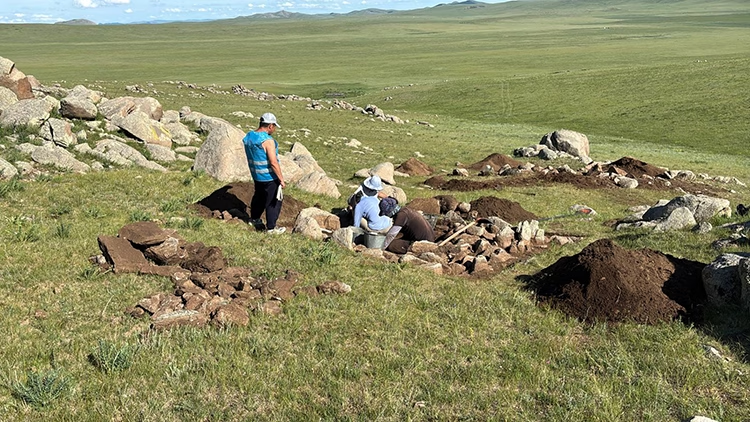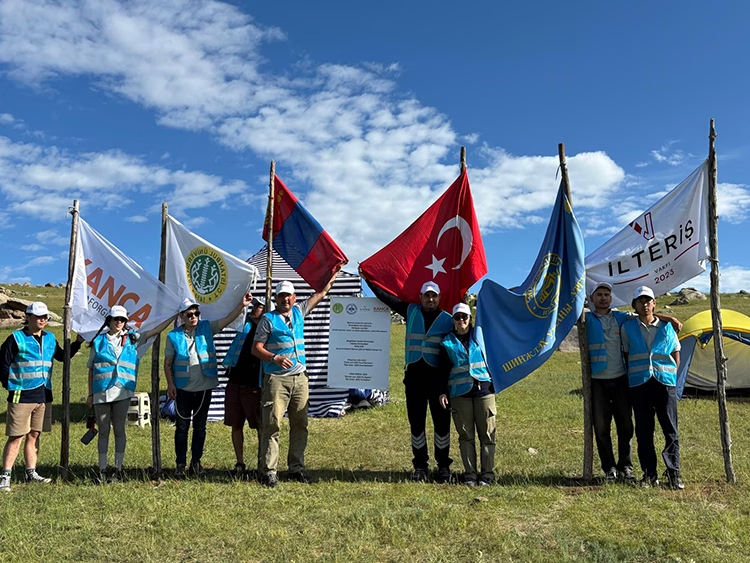Archaeological excavations under the joint “Riders’ Culture” project by Istanbul and Mongolian state universities have commenced this year. The current phase focuses on burial and monument sites linked to medieval nomadic communities in the Altanbulag district of Mongolia’s Tuv province.
Sponsored primarily by the İlteriş Foundation, the excavations are conducted at the Şovh Uul Mountain and Tuul River basin. The work aims to complete this year’s digs at the burial mounds (kurgans) and monument sites associated with Turkish and Mongolian nomads from the early Bronze Age to the 13th century.
In Arkhangai city, the team is excavating five kurgans on Bor Ovoo Hill, near the monument dedicated to Uighur Khan Moyen Çor, who ruled between 747-759 AD. These burial mounds span from the Bronze Age through the 13th century.
Leading the Turkish side of the excavation are Istanbul University historians Prof. Dr. Kürşat Yıldırım, Assoc. Dr. Elvin Yıldırım, and researchers Dr. Ferhat Çiftçi and Şeyma Sapma. The Mongolian team includes Assoc. Dr. Ulziibayar Sodnom, Prof. Dr. Erdene Myagmar, and researcher Tsenguun Ganbold.

Prof. Dr. Kürşat Yıldırım, head of the excavation, shared with Anadolu Agency that Bor Ovoo Hill has been a sacred site for nomadic peoples for millennia:
“Bor Ovoo is a sacred hill located next to the inscription monument of Uighur Khan Moyen Çor. Nomadic groups have conducted religious ceremonies here for thousands of years. The burial mounds, dating from around 2000 BC to the 13th century AD, include monumental tombs created within the framework of ancestor worship. This place is one of the ancient cultural sites in the steppe.”
Yıldırım explained that the name “Bor” means “brown” in Mongolian, while “Ovoo” refers to sacred piles of stones in both Mongolian and Turkish cultures. Even today, the local Mongolian population holds Bor Ovoo in high spiritual regard, often questioning excavation activities out of respect for its sanctity.
The excavation aims to uncover daily life artifacts such as bronze and iron tools and pottery fragments used by the nomads, which will provide valuable insights into Turkish and Mongolian funerary traditions.
“Collaborating with Mongolian experts, who have a strong tradition in steppe archaeology, enriches our work greatly,” Yıldırım noted. “This partnership enables knowledge exchange and supports the growth of steppe archaeology research in Turkey. Together, we contribute to new perspectives and future projects in our field.”

Artifacts recovered from the excavation will be inventoried and protected by Mongolian authorities. Some will be exhibited in local museums, as transporting them abroad for display involves significant legal and logistical challenges.
Mongolia is an unparalleled region for studying ancient Turkish archaeology:
Yıldırım emphasized, “From the Huns to the Uighurs, the Orkhon Valley and Ötüken—the central locations of early Turkish states—are situated here. We are excited to continue our productive cooperation with Mongolian colleagues in upcoming excavation projects.”
The team of about 25 experts will publish their findings in Turkish, Mongolian, and English scientific reports, contributing valuable knowledge to both academic circles and the wider public.




